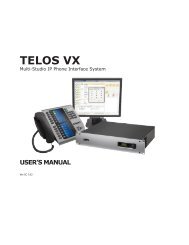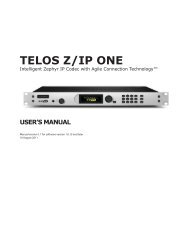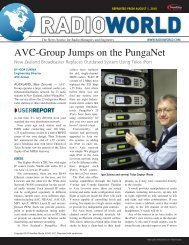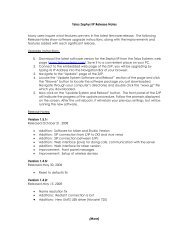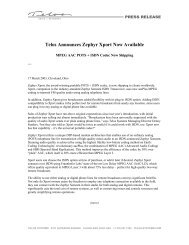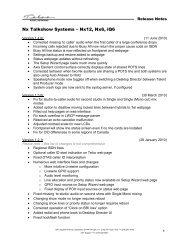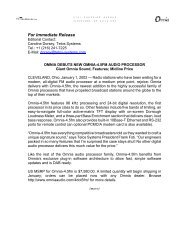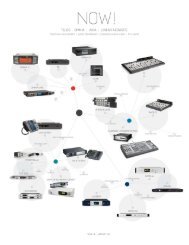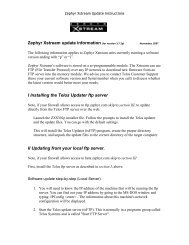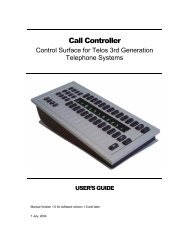Hx1-Hx2 Manual-1.4.1 - Telos
Hx1-Hx2 Manual-1.4.1 - Telos
Hx1-Hx2 Manual-1.4.1 - Telos
You also want an ePaper? Increase the reach of your titles
YUMPU automatically turns print PDFs into web optimized ePapers that Google loves.
A12 | appendix 1<br />
Northern Telecom- The Canadian company which was once the manufacturing arm of Bell<br />
Canada (it was called Northern Electric back then). Now called Nortel Networks. See Nortel.<br />
NT - Network Termination - The electrical and protocol specifications for the user end of an<br />
ISDN line. See also LT.<br />
NT-1- An alternative expression for NT1. See NT1.<br />
NT1- Network Termination Type 1. The termination at the customer premises of an ISDN<br />
BRI circuit. The NT1 performs the role of line termination of the “U” interface and Codes/<br />
Decodes from the line’s 2B1Q coding scheme. The customer end of the NT1 interfaces using<br />
the “S” or “T” interface. The NT1 is frequently part of the “Terminal Adapter” and is built-in to<br />
Zephyr Xstream, Zephyr, ZephyrExpress, <strong>Telos</strong> TWO and TWOx12 systems sold in the USA<br />
& Canada. See also NCTE.<br />
NTBA- Network Termination Basic Access. The term used for NT1 in some countries. See<br />
NT1. See also NCTE.<br />
OOS – Out of Service. An alarm light or condition on a T1 or trunk.<br />
Packet Switching. Packet Switched networks are more commonly associated with Computers,<br />
Local Area Networks, and the Internet. In a packet switched network the raw stream of data is<br />
broken into individual pieces, called packets. Each packet is routed through the data network,<br />
individually. This is somewhat analogous to taking the pages of a book and sending each page<br />
as a letter through the postal system. The page numbers would allow reassembly of the book no<br />
matter what order the pages were received at the far end. The end user does not know or care<br />
that the packets may travel a variety of routes. If a given page did not arrive in a reasonable<br />
length of time, one could request that this page be re-sent. Most packet switched systems allow<br />
packets to be discarded if the network capacity is exceeded (the postal system is not supposed<br />
to do this). This is accommodated by the higher-level protocol, which knows to request that<br />
a packet be re-sent if it does not arrive. Therefore, the typical behavior of a packet switched<br />
network when overloaded is that throughput decreases (i.e. the network “slows down”) as the<br />
percentage of discarded packets increases. In stark contrast to Circuit Switched networks. See<br />
Circuit Switching.<br />
Pair Gain - Pair gain is a method of transmitting multiple POTS signals over the twisted pairs<br />
traditionally used for a single traditional subscriber line in telephone systems. See SLC-96.<br />
PBX- Private Branch Exchange. A privately owned switch. Basically, a PBX is a private “business”<br />
telephone system which also interfaces to the telephone network. In some circles ‘PBX’<br />
implies a manual switchboard whereas ‘PABX’ (Private Automatic branch exchange) implies a<br />
PBX that supports dialing by end users.<br />
PIC- Primary Interexchange Carrier. (USA) This is your default “1+” carrier used for inter-<br />
LATA calls. In some areas you may have two PICs, one for interLATA calls, and one for<br />
intraLATA long distance calls (in which case it stands for Primary Intraexchange Carrier). In<br />
some areas intraLATA long distance calls are still handled by your RBOC, in others you now<br />
have a choice. You can identify who your current PIC is by dialing 700 555-4141.<br />
POP - Point Of Presence. The local facility where your IEC maintains a switch. This is where<br />
your long distance calls get routed so that your IEC can handle them. Also used to describe the<br />
local access point of an Internet Service Provider. Sometimes carriers maintain “Paper POP’s”,<br />
that is points of interconnection that are advantageous for regulatory reasons. These are often<br />
at Co-Location facilities (COLO’s) or “Telco Hotels”, which are large hardened data centers<br />
where many carriers and customers interconnect and terminate data and voice facilities.<br />
Port - This is a pretty general term. Newton’s Telecom Dictionary 10th edition defines a port as<br />
“An entrance to or an exit from a network”. Many phone equipment vendors refer to ports as the



